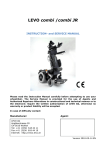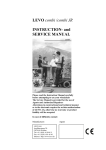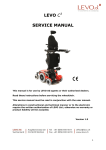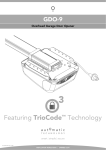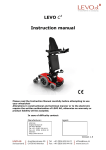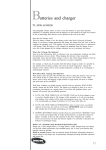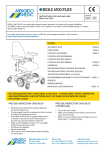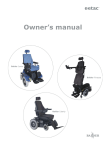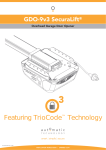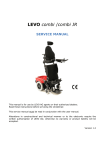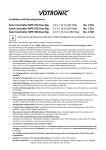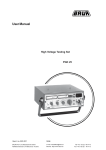Download LEVO Combi 922XXX & 923XXX Instruction & Service Manual
Transcript
LEVO combi /combi JR SERVICE MANUAL This manual is for use by LEVO AG agents or their authorised dealers. Read these instructions before servicing the wheelchair. This service manual must be read in conjunction with the user manual. Alterations in constructional and technical manner or to the electronic require the written authorisation of LEVO AG, otherwise no warranty or product liability will be accepted. Contents SERVICE MANUAL ................................................................................... 1 2. Health & safety ................................................................................... 3 3. Adjustments ....................................................................................... 3 Seat depth ...............................................................................................3 Low shearing at the back ............................................................................... 3 Adjustment of the backrest ............................................................................. 3 Electronic control system .............................................................................. 4 3.1. 3.2. 3.3. 3.4. 4. 5. 6. 7. 8. 9. Repairs: general instructions .................................................................... 4 Tools & torque settings .......................................................................... 4 Important points .................................................................................. 5 Recommended safety checks .................................................................... 5 Cleaning ........................................................................................... 7 Repairs ............................................................................................. 7 9.1. Replacing the drive wheels............................................................................. 7 9.2. Replacing the tire of a drive wheel .................................................................... 7 9.3. Replacing the front wheels ............................................................................. 8 9.4. Replacing the back wheel .............................................................................. 8 9.5. Replacing the gas spring of the back wheel ............................................................... 9 9.6. Replacing the wheel fork (front and back) .......................................................... 10 9.7. Replacing the connector of the back low shearing system .......................................... 10 9.8. Replacing the motor disengaging cable (free wheel device) ........................................ 11 9.9. Replacing the driving motor ......................................................................... 12 9.10. Replacing the batteries ............................................................................... 13 9.11. Replacing the joystick module R-net ................................................................... 13 9.12. Replacing the power module R-net ..................................................................... 14 9.13. Replacing the gas spring ............................................................................. 15 9.14. Replacing the actuator “standing” ................................................................... 16 9.15. Replacing the actuator “lift” ......................................................................... 16 9.16. Replacing the actuator “lying” ....................................................................... 17 9.17. Replacing the safety cut-out ......................................................................... 17 9.18. Replacing bulbs....................................................................................... 18 9.19. Replacing the light (front, white) .................................................................... 19 9.20. Replacing the indicator ............................................................................... 19 10. Testing the wheelchair ......................................................................... 20 11. Cleaning ......................................................................................... 20 12. Technical information .......................................................................... 20 12.1. 12.2. 12.3. 12.4. Measurements (metric) ............................................................................... 20 Measurements (imperial) ............................................................................. 21 General technical information ....................................................................... 22 Electromagnetic Interference (EMI) ................................................................. 23 13. Crash Test protocol............................................................................. 24 2 Introduction Apart from regular charging of the batteries and keeping the wheelchair clean the LEVO combi is maintenance-free and no attention is required by the user. Because of the complexity of the wheelchair the LEVO agent or authorised dealer should carry out a safety check at least once per year. This service manual is to be used by the LEVO agent or authorised dealer. The manual gives information on how to perform a safety check and carry out repairs to the LEVO combi. This manual provides a good service to the persons in charge of the maintenance of the LEVO combi. And of course, the user appreciates the safety and the reliability of a well maintained wheelchair. This manual must always be read and used with the user manual. 2. Health & safety Accidents do occur. When working on or testing the wheelchair be aware of the dangers and take care to ensure your own and other peoples health and safety. 3. Adjustments The majority of the adjustments can be carried out by the user or his family and are covered in the instruction manual. However, the LEVO agent should always, on delivery, adjust the wheelchair to suit the user. 3.1. Seat depth The adjustment of the seat depth should only be done by the LEVO agent or authorised dealer. For information consult the user instruction manual at section 7.1. 3.2. Low shearing at the back The adjustment of the low shearing at the back should only be done by the LEVO agent or authorised dealer. For information consult the user instruction manual at section 7.5. 3.3. Adjustment of the backrest The adjustment of the backrest should only be done by the LEVO agent or authorised dealer. For information consult the user instruction manual at section 7.6. and 7.7. 3 3.4. Electronic control system The preset settings are chosen to ensure safe operation. The settings are in compliance with all relevant legal requirements regarding the entire operating range of the joystick and the speed control. In case the preset settings don’t meet the needs of the user, the control system can be programmed individually; the maximum speed might be decreased for example. Warning: Programming should only be conducted by healthcare professionals with in-depth knowledge of Penny&Giles electronic control systems. Incorrect programming could result in an unsafe set-up of a wheelchair for the user. LEVO AG accepts no liability for losses of any kind if the drive or stability characteristics of the wheelchair are altered without prior notification and discussion with LEVO AG. It is in the responsibility of the person programming the control system to make sure that the stopping distance requirement specified for the country in which the wheelchair will be used is satisfied. If the braking rate is low, the forward and reverse maximum speed settings may need to be re-programmed. It is in the responsibility of the person programming the control system to make sure that the settings are safe and to note any programming changes made. 4. Repairs: general instructions Only a LEVO agent or their authorized dealers should carry out servicing and repairs to the LEVO combi. ! ! ! Repairs: For advice in all repairs in Switzerland contact LEVO AG, Switzerland. For all other countries contact your local LEVO agent. Addresses are given at the front of this service manual. Major repairs: For all major repairs, e.g. bent or damaged frame, always replace complete components. Never try to repair damaged steel work or components. Replacement parts: Factory replacement components should be used in all repairs, these are available from LEVO AG. To order parts see the parts list drawings and the correlative list, both available at LEVO AG. 5. Tools & torque settings The following tools are required to service the wheelchair: ! ! ! ! ! ! Spanners and sockets: 8 mm through to 24 mm. Hexagon key: 2 mm through to 8 mm. Screwdrivers: 1 Nm through to 50 Nm. Phillips head screwdriver and slotted screwdriver Soft headed hammer Snap through tool 4 Torque settings: Bolt size Torque Nm M4 M5 M6 M8 M10 3 6 10 25 50 6. Important points ! ! ! ! ! Do not reuse nuts. Always replace with a new nut. Always use thread locking compound. Always use recommended components and parts available from LEVO AG. Do not modify or repair the frame. LEVO AG is responsible for any repairs on gas springs, motors and electronic parts. 7. Recommended safety checks The following safety checks should be carried out at least once per year. This should be done by a LEVO agent or authorized dealer. If a fault is found do not allow the wheelchair to be used until it has been corrected. ! ! ! Make sure that the backrest, options and additional material is fixed safely. Using a V-Trak backrest system check the lever of the backrest. All levers have to be completely pushed down. Repair any fault found immediately. Examine the wheelchair frame for any damage. Replace any damaged or faulty components. ! Examine the condition of the seat cushion and the backrest cover (standard version), respectively the therapod back shell cover (V-Trak backrest system) and replace if necessary. ! Examine condition of all harnesses, straps and buckles and replace if necessary. ! Examine and operate the footrest mechanism. Replace any damaged or faulty components. ! Examine nuts, bolts, pivots and frame plugs for tightness and general condition. Replace any faulty components. ! Examine the rear wheel, the front wheels and their castors for free rotation and security. Optimize the rotation and repair any fault found. 5 ! The tires are maintenance-free besides occasional cleaning. Use a damp cloth for cleaning. Tires must get replaced when the tire’s profile is worn down. (For more information please consult sector 8.1. to 8.4.). ! Check the free wheel device and the motor disengaging lever for correct operation. Repair any fault found. ! Check the mechanical function of the motor disengaging lever. Pull the motor disengaging lever out and turn it simultaneously to the OFF position. At this stage it should be possible to push the wheelchair. Pull the motor disengaging lever out and turn it simultaneously to the ON position to activate the motor brakes. The power wheel should be blocked now. In case the power wheels are not completely blocked, it is absolutely necessary to replace the motor. ! Check the powered function of the motor disengaging lever. Switch on the joystick module and start driving forwards. Let of the joystick. As a reaction the wheelchair should stop and the solenoid brakes of the motor should snap in evidence. Repeat this check driving backwards and to each side. In case the motor brakes don’t function correctly check the battery indicator on the joystick module for any failure indication. Consult the controller self help guide (user manual sector 23) for details about failure indications. ! Make sure all the connectors are properly inserted, that the brake solenoids are energized and that the solenoid coil is not open or short-circuited by testing the two bigger pins on the motor lead plug. If necessary, replace the motor. ! Check all electrical cables and wires for chafing and clamp spots. Replace if necessary. ! Check all electrical connectors for corrosion and security. Replace if necessary. ! Clean the batteries and terminals. Test the battery capacity and advise the customer of their condition. Charge the batteries before returning the wheelchair to the customer. ! Check all MODE functions as standing-up and sitting as well as the optionally added functions (lift, backrest reclining, seat tilt, lying to standing directly). Repair any fault found. ! Check all lights and indications. Replace components with failures. ! Use all functions and drive the wheelchair as a final check. In case you notice any kind of problems arrange the fixing. 6 8. Cleaning Before returning the wheelchair to the customer ensure the wheelchair is clean and well presented: ! If there is any dirt it should be cleaned off using a damp cloth and then dried thoroughly. ! For more stubborn stains wipe with a damp cloth using a mild solution of warm water and soap. ! Never use furniture polish or any fluids containing alcohol to clean the frame. ! In case of dirt on the seat cushion cover or the back rest cover, you can remove both of it and wash it softly. Do not wash it warmer than 40 degree Celsius. 9. Repairs 9.1. Replacing the drive wheels When removing a wheel, the wheelchair must be unoccupied. The wheelchair must be supported (B) so that it neither falls over or moves when a wheel is removed. ! A ! 1 9.2. B ! ! ! Pull off the protective end cap which covers the countersunk screw. Remove the countersunk screw (A) using a 5 mm hexagon key. Remove then the black washer (F, picture 2). Withdraw the wheel from the wheelchair. To mount the new wheels follow the instructions in the reverse order. Replacing the tire of a drive wheel When replacing the tire, means removing a wheel, the wheelchair must be unoccupied. The wheelchair must be supported so that it neither falls over or moves when a wheel is removed. ! Remove the drive wheel as described in sector 8.1. ! Remove the four black countersunk screws (G) to take the flange © of the wheel using a 5 mm hexagon key. ! Remove five screws (H) of the rim using a 6mm hexagon key. ! Withdraw the rims (B1 and B2) from the tire (A). ! Reassemble in reverse order. ! To fit the rims to the tire use gunk to make it easier. 7 Important: Take note of the circulation direction indicated on the tire before fixing. 2 C D 9.3. B1 E F B2 A G H Replacing the front wheels When removing a wheel, the wheelchair must be unoccupied. The wheelchair must be supported so that it neither falls over nor moves when a wheel is removed. ! ! ! ! ! ! ! A Pull off the protective end caps from the axle. Loosen the hexagon screw and washer using a 13 mm hexagon key and remove the screw, the washer and the nut (A). Withdraw the wheel from the fork. Reassemble the new wheel in reverse order. Make sure all washers are placed correctly! 3 9.4. Replacing the back wheel When removing the wheel, the wheelchair must be unoccupied. The wheelchair must be supported so that it neither falls over or moves when the wheel is removed. ! 4 A ! ! ! Loosen the screw (A) using a 6 mm hexagon key and remove the screw, the washer and the nut. Withdraw the back wheel from the fork. Reassemble the new wheel in reverse order. Make sure all washers are placed correctly! 8 9.5. Replacing the gas spring of the back wheel ! Lift the back wheel up with a clamping set. 4a ! Remove the supporting handle notice. 4b ! Loose the clamping set, so that the gas springs are relieved. 4c ! Remove the securing clips at both gas springs above and below with a screwdriver. ! Now you can take off the gas springs from the ball pin and exchange them. ! Install everything again in reverse order. 4d 9 9.6. Replacing the wheel fork (front and back) A When removing a wheel and/or a wheel fork, the wheelchair must be unoccupied. The wheelchair must be supported so that it neither falls over nor moves when a wheel is removed. ! ! ! ! Loosen the hexagon spike (A) at the wheel fork axle as much as it needs to withdraw the fork from the mount. (Use a 24 mm hexagon key.) Replace the wheel fork. Reassemble the used wheel in case it is still in a good condition. Doing so please follow the instruction in sector 8.3. respectively 8.4. Mount the new wheel fork in the reversed order. (Picture 3 shows all parts in details.) 5 9.7. Replacing the connector of the back low shearing system As a standard a connector of medium size is fixed. The shearing range regarding the back movement is 9 cm / 3,5”. The replacement of this connecting piece using a shorter or a longer piece causes a variation of 8 cm / 3” respectively 10 cm / 4” of the shearing range. 6 ! Raise the seat to its maximum upright standing position. ! Switch off the joystick module. ! Loosen the fillister head screw at the backrest tube as well as the double-head screw at the seat plate using a 4 mm hexagon key. ! Remove the mentioned screws, the washers and the connector. First mount the upper end of the new connector at the backrest tube. Make sure to put the two washers back in place. After that mount the lower end of the new connector at the seat plate using the corresponding punched hole (A on picture 6 and 7). Again make sure to put the two washers back in place. 7 10 9.8. Replacing the motor disengaging cable (free wheel device) ! Raise the seat to its maximum upright standing position. ! Switch off the joystick module. ! Remove the cover of the motor loosening both screws using a 4 mm hexagon key. 8 A B Right hand side motor disengaging cable Cut the right hand side motor disengaging cable (B) from the cable clamp (A). (See picture 8). 9 ! Withdraw the motor disengaging cable backwards. ! Make sure the motor disengaging lever is at the ON position. E ! Lead first the new motor disengaging cable through the adjusting screw ©. The nut (D) should be centred at the D C adjusting screw ©. ! Lead then the cable through the hole of the disengaging motor and through the other hole in the metal piece (E) on the motor. ! Lead further the cable through the cable jacket and around the disengaging shaft. ! Adduct the cable that a slight tension occurs. The cable should not escapade of the disengaging shaft spline. ! Tighten the pen headed slotted screw around the cable clamp using a slotted screw driver. ! Left hand side motor disengaging cable ! ! ! ! ! ! ! ! ! Cut the left hand side motor disengaging cable (B) from the cable clamp(A)(See picture 8) Withdraw the motor disengaging cable backwards out. Make sure the motor disengaging lever is at the ON position. Lead first the new motor disengaging cable through the adjusting screw ©. The nut (D) should be centred of the adjusting screw ©. Lead then the cable through the hole of the disengaging motor and through the other hole in the metal piece (E) on the motor. Lead the cable through the small tubes at both side of the battery box. Lead further the cable through the cable jacket and around the disengaging shaft. Adduct the cable that a slight tension occurs. This cable should not escapade of the disengaging shaft spline. Tighten the pen headed slotted screw around the cable clamp using a slotted screw driver. 11 First controlling: turn the motor disengaging lever to the OFF position and check if the motor is unlocked. In case it is not unlocked turn the nut (D) on the adjusting screw © forwards as far as it needs to unlock the disengaging motor, the lever set on the OFF position. Second controlling: turn the motor disengaging lever to the ON position and check if the motor is locked. In case it is still unlocked turn the nut (D) on the adjusting screw © backwards as far as it needs to lock the disengaging motor, the lever set on the ON position. Shorten the end of the cable at 15 mm and clamp the cable end-protector piece. Fix the motor cover in the reverse order. ! ! ! 9.9. Replacing the driving motor When removing the driving motor, the wheelchair must be unoccupied. The wheelchair must be supported so that it neither falls over or moves while replacing the driving motor. A 10 B 11 ! Switch off the safety cut-out. ! Open the cover of the battery box and disconnect the motor plug (A) from the power module. ! Remove first the drive wheel as described in sector 8.1. ! Remove the motor cover loosening the screws using a 4 mm hexagon key. ! Loosen the motor disengaging lever cable. ! Now loosen the four cylinder head screws (B) at the motor using a 6 mm hexagon key. ! Mount the new motor with the four cylinder head screws (B) using the 6 mm hexagon key again. ! Fix the disengaging motor cable as described in sector 8.7. ! Reassemble the motor cover. ! Mount the drive wheel in the reverse order. ! Connect the motor plug to the power module. ! Switch on the safety cut-out. 12 9.10. Replacing the batteries Caution: The battery box is heavy, take care when lifting and carrying. Caution: When working on the batteries take great care not to short out the terminals with any metal tools etc. Always remove wristwatches or jewelry. When reconnecting make sure all wires are connected to the correct battery terminals. Caution: Contact with acids is dangerous. If you come into contact with acids, rinse the contaminated body parts immediately with water and consult your doctor. Take off immediately using acid contaminated clothing. Caution: Always wash your hands after working on the batteries. ! A ! ! ! B ! ! ! 1 If possible, raise the seat to the fully upright position. Switch off the safety cut-out. Open the battery cover. Loosen the screws at the electrical contact of the batteries using a 13 mm screw wrench and remove the small metal terminal piece (A). Lift the batteries out of the battery box. Put the new batteries in the battery box. Reassemble in the reverse order. The batteries should always be replaced as a complete set. 9.11. Replacing the joystick module R-net ! ! ! A ! ! Switch off the joystick module. Unplug the joystick cable at the back of the joystick module. Loosen the two hexagon screws (A) at the back of the joystick module using a 2.5 mm hexagon key and remove them. Lift the joystick module. Mount the new joystick module in the reverse order. 13 9.12. Replacing the power module R-net Raise the seat to its maximum upright standing position. ! Switch off the safety cut-out on the battery box. ! Open the cover of the battery box. ! Loosen the 4 screws that hold the limit switch plate , and remove the plate ! Cut the cable ties ! Lift the power module, that you get access to the front of the power module ! Unplug the following cables from the power module: ISM-cable (A), left motor cable (B), battery cable (C), right motor cable (D), limit switch cable (E), limit switch cable (F) (all cables are listed from the left to the right hand side, see picture 14). ! ! 14 A B D E F Please notice the interlocking of the different plugs: ! Motor cable plug: press the release catch at both sides of the plug. ! Battery plug: press the release catch at the upper side of the plug. ! The power module is fixed with a Velcro fastener at the bottom of the battery box. ! Reverse the above to refit. 14 9.13. Replacing the gas spring The gas spring serves for easy manual raising of the seat in case of any disorder considering of the batteries or the actuator “standing” and you still need access to the battery box in order of any repair. The gas spring raises the seat and supports it in the standing position without the actuator “standing” in use. ! ! Raise the seat to the maximum standing position. Lift the clip (B) on the upper part of joint of the gas spring using a slotted screwdriver (A) and press the joint part off the joint pivot (C). Caution: Do not remove the clip! Lift the clip on the lower part of the joint of the gas spring using a slotted screwdriver and press the joint part off the joint pivot. Caution: Do not remove the clip! Remove the gas spring now. Mount the new gas spring in the reverse order pressing the ends on the correlative joint pivot. A C B 15 15 9.14. Replacing the actuator “standing” 17 16 A ! ! ! ! ! ! ! ! B A Raise the seat to the upright standing position. Switch off the joystick module and the safety cut-out. Remove the quick-release axle (A, picture 16) from the upper end of the actuator. Push the seat further to the upright position as high as it needs to remove the actuator off the recess drilled into the seat support. In case the seat is already at the maximum standing position the gas spring has to be unfixed at the upper end. (Read the instruction in sector 8.13.) Remove the clip (A, picture 17) at the inside of the lower end of the actuator. Press out the spike (B, picture 17), use a hammer and a snap through tool to strike the spike carefully out of the rod. Unplug the actuator from the battery box and remove it. Reassemble the new actuator in the reverse order. 9.15. Replacing the actuator “lift” If the chair is supplied with the relax/lying function as an option get the chair in the maximum lying position. A B It is hard access to the actuator “lift” if there is no such function added. ! Switch off the joystick module and the safety cut-out. ! Support the lower base of the yoke (A) using a log (B) or wooden rod that might be a broomstick for example to secure the lift from falling down. (See picture 18.) 18 ! Unplug the actuator “lift” from the battery box. ! Remove the clip (A on picture 17) at the upper end of the actuator. ! Press out the spike (B on picture 17), use a hammer and a snap through tool to strike the spike carefully out of the rod. ! Remove the actuator from the upper end of the halter of the actuator. ! Detach the clip (A on picture 17) at the lower part of the actuator and remove the spike as described before. ! Now remove the actuator. ! Reassemble the new actuator “lift” in the reverse order. ! Take care that the piston rod of the new actuator is retracted (inside). Start work at the lower part of the actuator and connect the plug of the actuator at the battery box first. Retract the piston rod until it fits to the halter of the actuator “lift”. 16 9.16. Replacing the actuator “lying” ! ! 19 ! ! ! ! ! ! A ! ! ! Raise the seat to the upright standing position. Switch off the joystick module and the safety cut-out. Disconnect the plug of the actuator “lying” from the battery box. Loosen the screw (A on picture 19) using a 8 mm flat wrench. Remove the back end of the actuator from the connecting part. Remove the clip (A on picture 17) at the front end of the actuator. Press out the spike (B on picture 17), respectively use a hammer and a snap through tool to strike the spike carefully out of the rod. Press the front end of the actuator down and off the halter. Pull it then to the front and off the back halter. Now remove the actuator. Reassemble the new actuator “lying” in the reverse order. Take care that the piston rod of the new actuator is retracted (inside). Start work at the front part of the actuator and connect the plug of the actuator at the battery box first. Retract the piston rod until it fits to the halter at the back. 9.17. Replacing the safety cut-out A B C 1 2 To replace the safety cut-out the seat needs to be in the standing position for access to the safety cut-out and the battery box. In case the seat is locked in the sitting position or the safety cut-out is set in the OFF position , then the actuator “standing” has to be detached at the upper end and the seat has to be raised manually. (Consult sector 8.14 for instructions considering the detachment of the actuator “lying”.) 17 ! ! ! ! Remove the nut (A) at the safety cut-out switch using a 14 mm slotted screw driver. Open the cover of the battery box. Disconnect both connectors at the safety cut-out (B) loosening two thruss head screws (C) using a small slotted screw driver. Replace the safety cut-out in the reverse order. 9.18. Replacing bulbs Important instructions for replacement of indicators, indicators and bulbs: Caution: Always switch off the safety cut-out first before any part of the lighting system will be replaced or fixed. Caution: Never touch a bulb at the glass casing with bare fingers. This effects the life time of the bulb most negatively. ! ! ! Lights infront, white 12V 5W Indicators infront and backside, orange indicator unit Lights backside, red 12V 5W Replacement of the bulb in a light (front, white) ! ! ! ! Press down the black securing device at the underside of the lamp. The release of the white lamp cover is possible now. On the reflector, opposite of the white lamp cover, there is a black securing ring, holding the light bulb. Remove the black ring including the bulb. After changing the bulb, replace the lamp in the reverse order. 18 Replacement of the bulb in a light (back, red) A ! Open the cover of the battery box. ! Turn the bayonet fixing (A) (the bulb is integrated in this part) counter clock wise and take it out of the casing. ! Remove the bulb from the thread. ! Replace the bulb in the reverse order. 22 9.19. Replacing the light (front, white) ! ! ! The front lights are mounted on at the same holder like the indicator unit. First plug off the cable socket at the rear side at the lamp. To change the lamp, you need only to loosen the alen screw,(M4), with security nut. The lamp will be loose and can be replaced. 9.20. Replacing the indicator Blinker at the front ! ! ! ! Please remove first the red cable socket. To separate the indicator unit, you need an open end spanner, number 17. Loosen the nut, which is mounted on at the inner side of the light holder. In case the nut is too much tighten, it will be necessary to use a second spanner, to hold the counter nut outside of the light holder. Remove the inner nut. It will be possible to pull out the complete light holder. Blinker at the backside Removing or changing the rear indicator unit, you can follow up the same steps, like for changing the front indicator unit. 19 10. Testing the wheelchair Always perform full functional tests on the wheelchair when repairs have been completed and before it is returned to the customer. Only return the wheelchair to the client when all faults have been rectified. 11. Cleaning Before returning the wheelchair to the customer ensure the wheelchair is clean and well presented: ! ! ! If there is any dirt it should be cleaned off using a damp cloth and then dried thoroughly. For more stubborn stains wipe with a damp cloth using a mild solution of warm water and soap. Never use furniture polishes or spirit to clean the frame. 12. Technical information 12.1. Measurements (metric) Model S-M Seat width 38 / 44 / 50 cm Seat depth adjustable (incl. leg protector) 36 - 47 cm Seat height (from top of cushion) 56 - 71 cm Armrest height (from top of cushion) 11 - 27 cm Footrest height (from top of cushion) 37 - 58 cm Back height (incl. standard back upholstery) 43 cm Overall width 66 cm Overall length 110 cm Smallest turning circle (diameter) 110 cm Overall height (incl. standard back upholstery) 89 – 104 cm Speed 0 – 10 km/h Range (55 Ah batteries) 35 km Max. gradient (sitting position) 10° Max. gradient (standing position) 3° Kerb climbing ability (sitting position) 6 cm Kerb climbing ability (standing position) 1 cm Measurements LxWxH (no back system included) 93 x 66 x 67 cm Max. weight 170 kg Max. total load 120 kg L-XL 47 - 58 cm 20 12.2. Measurements (imperial) Model S-M Seat width 15 /17/20“ Seat depth adjustable (incl. leg protector) 14 – 18,5“ Seat height (from top of cushion) 22 – 28“ Armrest height (from top of cushion) 4 – 11“ Footrest height (from top of cushion) 14,5 – 23 „ Back height (incl. standard back upholstery) 17“ Overall width 26“ Overall length 43“ Smallest turning circle 43“ Overall height (incl. standard back upholstery) 35 – 41“ Speed 6mph Range (55 Ah batteries) 22 miles Max. gradient (sitting position) 10° Max. gradient (standing position) 3° Kerb climbing ability (sitting position) 2,4“ Kerb climbing ability (standing position) 0,4“ Measurements LxWxH (no back system included) 36x26x26,5“ Max. weight 375 pounds Max. total load 265 pounds L-XL 14,5 – 23 „ 21 12.3. General technical information Drive wheels Diameter 350 mm x 70 mm; 14” x 2¾“ Tires No breakdown risk Front wheels Diameter 200 mm x 50 mm; 8” x 2” Tires No breakdown risk Diameter 140 mm x 40 mm; 5½“ X 1½“ Back wheels No breakdown risk Tires 0 - 10 km/h precision controlling Speed (There exist regulations considering speed limits for wheelchairs in certain countries. These regulations have to be observed!) Drive motor 4-Pl 24 V DC, 350 W / Brakes: 12 V DC (Micro Motor) Drive motor actuator 24 V DC, 350 W Maintenance-free lead accumulator in fleece technology Batteries 55 Ah 2 pcs. 12V / 55 Ah type „Sonnenschein“ dryfit A 500 Size: 260x135x230 mm/pc., weight: 18 kg/pc. Max. discharge power for 6 minutes 72 A Approximately 35 km / 22 miles Note: Range is affected by the load carried, hills climbed and temperature. Range Maximal tolerable gradient 10° (25%) (static) Maximal curb climbing 6 cm/2,4” ability Typ G2-300 24 V DC Charger The no-load voltage is 27.6 V, measured across pins 1 and 3 on the charging plug. Maximal load including all objects carried along Wheelchair category 120 kg/265 pounds B 22 12.4. Electromagnetic Interference (EMI) We recommend to consult the sector 12 of the user manual for important information about electromagnetic interference. Advice Following the advice listed below should reduce the chance of unintentional brake release or powered wheelchair movement. Do not operate hand-held transceivers (transmitters-receivers), such as citizens band (CB) radios. Do not switch on personal communication devices, such as cellular phones, while the powered wheelchair is turned ON. Be aware of any nearby radio or tv station transmitters and try to avoid going close to them. If unintentional movement or brake release occurs, turn the powered wheelchair OFF as soon as it is safe to do so. Report all incidents of unintentional movement or brake release to the manufacturer, and note whether there was a radio wave source nearby. Finally, be aware that adding accessories or components, or modifying the powered wheelchair, may make it more susceptible to EMI. LEVO AG cannot take any responsibility for the effects of EMI if your wheelchair has been altered in any way. 23 13. Crash Test protocol 24 25


























